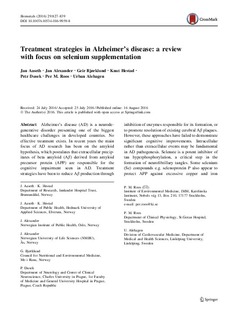| dc.description.abstract | Alzheimer’s disease (AD) is a neurodegenerative disorder presenting one of the biggest healthcare challenges in developed countries. No effective treatment exists. In recent years the main focus of AD research has been on the amyloid hypothesis, which postulates that extracellular precipitates of beta amyloid (Ab) derived from amyloid precursor protein (APP) are responsible for the cognitive impairment seen in AD. Treatment strategies have been to reduce Ab production through inhibition of enzymes responsible for its formation, or to promote resolution of existing cerebral Ab plaques. However, these approaches have failed to demonstrate significant cognitive improvements. Intracellular rather than extracellular events may be fundamental in AD pathogenesis. Selenate is a potent inhibitor of tau hyperphosphorylation, a critical step in the formation of neurofibrillary tangles. Some selenium (Se) compounds e.g. selenoprotein P also appear to protect APP against excessive copper and iron deposition. Selenoproteins show anti-inflammatory properties, and protect microtubules in the neuronal cytoskeleton. Optimal function of these selenoenzymes requires higher Se intake than what is common in Europe and also higher intake than traditionally recommended. Supplementary treatment with N-acetylcysteine increases levels of the antioxidative cofactor glutathione and can mediate adjuvant protection. The present review discusses the role of Se in AD treatment and suggests strategies for AD prevention by optimizing selenium intake, in accordance with the metal dysregulation hypothesis. This includes in particular secondary prevention by selenium supplementation to elderly with mild cognitive impairment. | nb_NO |

